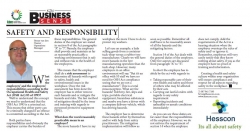Bryan van den Heever - Operations Manager : Safety And Responsibility2017-04-18 What are the employers' and the employees' responsibilities according to the Occupational Health and Safety Act (OSH Act) 85 of 1993? Well to understand this concept we need to understand that the OSH Act 1993 is a criminal act. This means that either party can be criminally charged if an offence is committed according to the Act.
Both parties have responsibilities and obviously the employer carries the burden of these responsibilities. The general duties of the employer are stated in section 8 of the Act paragraphs "A" to "J". Namely, the employer shall provide and maintain as far as reasonably practicable a working environment that is safe and without risk to the health of the employees. This means that the employer shall do a risk assessment to determine all hazards with regard to safety, health and environmental issues in the workplace. Once the risk assessment has been done the employer has to either remove such hazards and or mitigate the hazards and risks. The last method of mitigation should be the issue and training with regards to personnel protective equipment (PPE). What does the word reasonably practicable mean to an employer? The more hazards I have in my workplace the more I have to do to protect my workers. Let's use an example, a lady selling goods from a container tuck-shop versus a rubber tyre manufacturer. Clearly we will have more hazards in the tyre manufacturing operation than the tuck-shop. However, many employers in an office environment will say, "But it's an office with 10 staff we have no need for OSH Act compliance seeing that we are not a manufacturer". This is a total misconception. What are the hazards? Robbery, fire, slips and trips, portable electrical equipment, hazardous substances and maybe you have a driver with a company delivery vehicle, which has driving hazards. The employer has to determine these hazards either by themselves and/or with help from safety practitioners. The mitigation implementation will follow as soon as possible. Remember all staff have to be reasonably aware of all the hazards and the mitigating factors. Section 14 of the Act deals with the general duties of the employee. Only five aspects are discussed from paragraph "A" to "E". In short the employee has to abide by the act with regards to:
Creating a health and safety culture within your organisation will ensure compliance and respect for all aspects regarding safety in the workplace. T: 087 941 7180 bryan@hesscon.co.za www.hesscon.co.za |
Bryan van den Heever - Operations Manager : Safety And Responsibility
Copyright © 2024 KwaZulu-Natal Top Business
